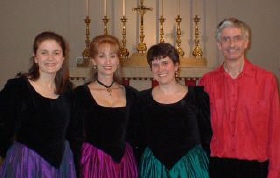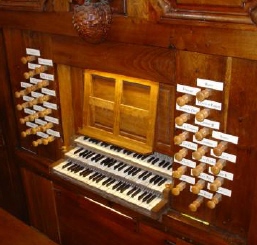| Charpentier at Rozay-en-Brie

Concerto delle Donne: Donna Deam, Faye Newton and Gill Ross
with sopranos Miriam Allan, Caroline Ashton, Rachel Bevan, Jennie Cassidy, Charlotte Fairbairn and Ana Gabriela Schwedhelm
Directed by Alastair Ross (organ)
Signum SIGCDO73 [69 mins]
Lebègue Prelude du cinquieme ton (C major)
Charpentier Antiphon Ave Regina coelorum H.19;
Motets Sicut spina rosam H.309: Gaude felix Anna H.315
LebègueTierce en taille du deuxieme ton (G minor)
Nivers Antiphon Gabriel Angelus
Charpentier Magnificat pour Ie Port Royal H.81; Antiphon Alma redemptoris mater H.21; Motet Frigidae noctis umbra totum;
In Nativitate Domini N(ost)ri Jesu Christi Canticum
LebègueNoel: ou s'en vont ces gays bergers?
Attrib. Lully Antiphon Salve Regina
Nivers Recit de cromorne du troisieme ton (A minor)
Charpentier Sequence Stabat Mater pour les religieuses H.15
Nivers Dialogue a deux choeurs du sixieme ton (F major)
Charpentier Antiphon Regina coeli laetare H.32; Hymn Gaudia Virginis Mariae H.59
Lebègue Plein Jeu du huitieme ton (G major)
A wholly delightful sequence of 17C music which would have been given by nuns, trained in singing, at the Convent of Port-Royal and elsewhere.
The soprano voices here carry their considerable expertise unshowily, just right for the descriptions of the time, e.g. "sweet, distinct, articulate, harmonious, touching, moving [listeners] to tears, and at the same time, filling their hearts with joy and consolation."
 The famous organ at Rozay-en-Brie has been restored to its 17C glory; it still has its original keys, upon which the Couperins would have played, in playable condition. An illustration on the Rozay-en-Brie website (a painting by an organist) shows that there is a gallery where the singers might have been placed. Whether or not for this recording, the ensemble with Alastair Ross is immaculate. The famous organ at Rozay-en-Brie has been restored to its 17C glory; it still has its original keys, upon which the Couperins would have played, in playable condition. An illustration on the Rozay-en-Brie website (a painting by an organist) shows that there is a gallery where the singers might have been placed. Whether or not for this recording, the ensemble with Alastair Ross is immaculate.
His own solos punctuate the vocal music ideally, and display the beauties of the historic organ in its perfect acoustical setting. There are motets for two, and three voices and solos for all three. My only disappointment was with the four-square motet "attrib. Lully". Charpentier's daringly simple Stabat Mater, nine minutes long, which holds attention easily through its ten identical verses varied only by the alternation of soloists and supporting choir, is a good one to get to know the three voices of the pricipal Donne. Then the mood lightens with music to celebrate the Ressurection and the Coronation of the Virgin, ending with a celebratory Plein Jeu by Lebègue which shows the full glory of the Rozay organ.
They can be heard on line in two generous Carissimi tracks at http://www.concertodelledonne.com/ This new CD is to be launched in London at St John's, Smith Square on 16 February; a concert well worth catching.
See also http://www.musicalpointers.co.uk/reviews/cddvd/CharpentierMotets.htm
Music for the Virgin Mary 16 February 2006 St John’s Smith Square, London
Concerto delle Donne
Donna Deam, Faye Newton, Gill Ross, Jennie Cassidy – sopranos
with Caroline Ashton, Philippa Behrman, Charlotte Fairbairn, Poppy Holden, Ana Gabriela Schwedhelm - sopranos ;
Ian Pritchard - organ
Alastair Ross – director and organ
16 February 2006 St John’s Smith Square
This concert was planned in celebration of 300 years of Marc-Antoine Charpentier (1643-1704) and coincided with the launch of Concerto delle Donne's new CD on the Signum label, already reviewed above and applauded by MP.
In fact the concert was a live recreation of the CD, and a great showcase for the talents of this ensemble: lovely voices, intelligently used, perfectly balanced and blended.
Alastair Ross gave an interesting pre-concert talk, describing the vicissitudes attending successful realisation of his determination to take the team to the small village of Rozay-en-Brie to make the recording, despite warnings from his prudent colleagues about its impracticability and cost. He made light of the task of directing the concert at St John's from one of the two chamber organs. Everything worked in perfect harmony, including one surreal moment in which the duetting organs were joined by a ring-tone melody from the audience!
There has been much erudite study in recent years regarding Latin pronunciation in medieval times, and the group have been meticulous in applying an authentically French baroque accent. It may not sit comfortably on the ear for those accustomed to Italianate or conventional church Latin and I found the words transformed almost beyond recognition, a case of lucidity being sacrificed to legitimacy - in much the same way that I don’t think I would choose to attend a Shakespeare play performed in 17th century English.
No such problems with their lovely encore – the Judex from Gounod’s Mors et Vita – surely one of the finest tunes ever written, and given an outstanding performance.
Serena Fenwick
|



